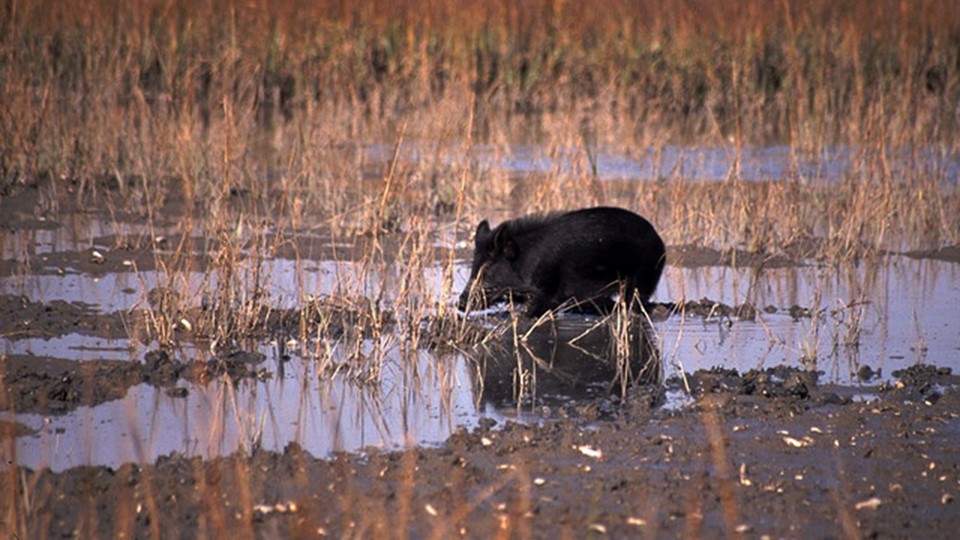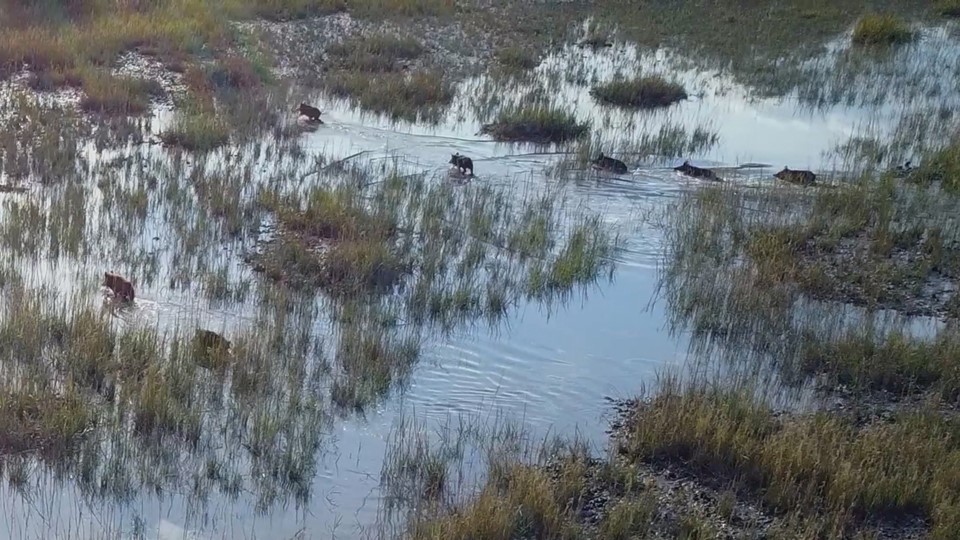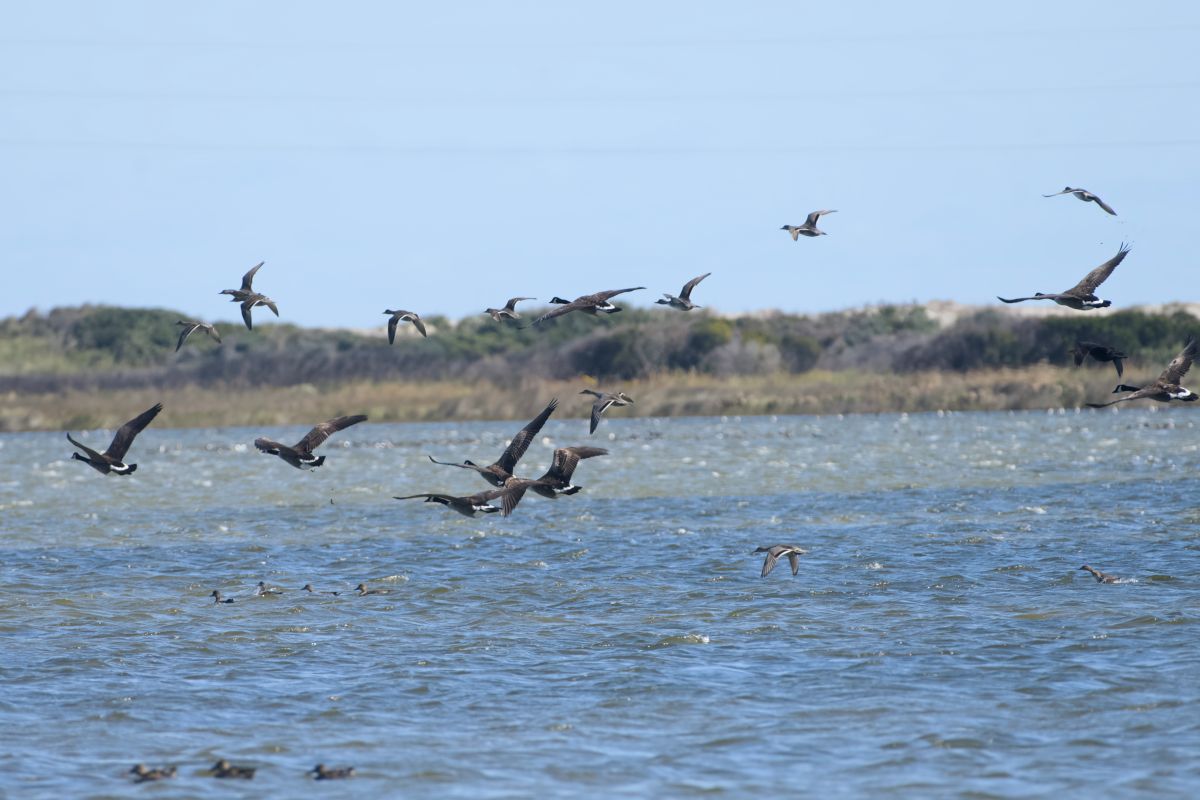
One of nature’s bounce-back coastal ecosystems has a new enemy, an invasive species that has been found to significantly slow the pace at which a salt marsh can adapt to climate change-related issues.
Feral hogs.
Supporter Spotlight
Yes, you read that right. Feral hogs.
“What we know about salt marshes is they’re this amazing resilience system that aren’t being affected as much by climate change as other ecosystems,” said Brian Silliman, Rachel Carson Distinguished Professor of marine conservation biology at Duke University. “They’re recovering. They die off with big drought stress or heat stress, but they come back pretty fast and that’s unlike coral reefs. They come back faster than mangroves and they come back faster than seagrasses. They just come back fast.”
But feral hogs and their hankering for mussel mounds that thrive in salt marshes are drastically slowing the rate at which these marshes can recover from drought and sea level rise, according to a recently published study Silliman co-authored.
Hogs are omnivores. They’re particularly keen on eggs and wreak havoc on the nests of ground birds. (Remember Angry Birds, the popular children’s game-turned-movie?)
Researchers initially suspected the hogs were maybe grubbing for the roots of plants in the salt marshes where it was evident hogs roamed, their signature telltale sign of existence is the trails they created trampling from one food source to another.
Supporter Spotlight
“If you’re walking along a trail, you look down and you see a lot of hog poop and you look in that hog poop and it’s just full of these mussel shells,” Silliman said.
With one bite, a hog can easily break the relatively soft mussel shell and gobble the mussel nestled within.
“When they get to the areas that are particularly attractive, in this case there’s a lot of mussel mounds, that’s what they’re after. They’ll spread out and two or three of them will concentrate on these mussel mounds that are maybe 5 feet across and they’ll really go to town,” Silliman said.
These mussel mounds play a particularly unique, and quite critical, role in a salt marshes’ resilience.
Christine Angelini, an assistant professor in environmental engineering sciences at the University of Florida, who was a research student working with Silliman at the time of the study, discovered that mussels have a partnership with Spartina, also known as cordgrass.
“Even though mussels only cover 1% of the marsh surface, there’s mounds every 10 meters,” Silliman said. “It’s like the perfect place for marsh grass to grow. The mussels poop on their roots so they get extra nutrients. They retain water so they don’t dry out. They harbor little crab predators in between the mussels and the predators kill any snails that might eat the grass. If you’re going to live anywhere in the marsh it’s like the super nice Waldorf Astoria of a mussel.”
When a marsh comes under stress, say, by a drought, most of the marsh grass dies. Grass on mussel mounds live.
“What happens is after the drought subsides those places act like nucleating startup spots and the rest of the marsh regrows from those areas through sprouting,” Silliman said. “So, if you don’t have those mussels there, the whole marsh dies and then it’s going to recover and actually be in a state of decline like the other ecosystems.”
Mussel mounds are just as important to salt marshes when it comes to their ability to adapt to sea level rise.
“Both the presence of grasses and the mussels on the shoreline leads to the accumulation of mud and elevations increase over time,” Silliman said. “The mussels are much better at it than the grasses. The grasses just slow down the water and the sediments fall out. The mussels are active filter feeders and so they’re concentrating mud in areas and it could grow a couple of inches a year in elevation and have no problem keeping up with sea level.”

Feral hogs are very abundant animals that are only increasing in number.
The more hogs in a marsh, the more destruction to that marsh.
“What happens is when the hogs come in, you eliminate those organisms that can build land,” Silliman said. “You’ve got to have those mussels around. The hogs love those mussels. What they do is get rid of the key partner that underlies this magical resilience that marshes have.”
Coastal marshes are a defensive line in nature. They filter nutrients and pollution from water, buffer storm surge during hurricanes and other coastal storms, and support breeding grounds for a variety of fish.
Silliman has worked for years in salt marshes, studying, along with fellow researchers, marine organisms like mussels and crabs.
While their attention was turned on the smaller creatures living in the marsh, they couldn’t help but notice the recurring presence of two big animals that didn’t belong in the marshes in which they were conducting research: alligators and feral hogs.
“For hogs, you can really see they’re really leaving a big mark on these salt marshes in areas where they’re dense and you can see that with drones,” Silliman said. “The drones are revolutionizing the study of large animals because large animals, really the ones that are left are really adept at avoiding humans in most cases. Without the drones in the study it just doesn’t become as relevant because we can’t access those marshes. We wouldn’t be able to do this big survey and people, in general, probably us too, would think this is a relatively isolated case and you just happened to stumble across a marsh that was hit really heavy by hogs.”
Silliman and his colleagues focused on Sapelo Island National Estuarine Research Reserve in Georgia, where researchers first noticed feral hogs were impacting marshes nearly a decade ago.
Researchers also looked, through the use of drones, at marshes in northern Florida, where the habitat is similar to that of Sapelo Island, the fourth largest in the chain of Georgia’s coastal islands.
“We haven’t done it here in North Carolina,” Silliman said. “We’re looking to do that.”
He first has to find a student to use drones to identify coastal marshes inhabited by feral hogs.
Feral hogs are a well-known nuisance in Currituck County, the northeastern most county in North Carolina and home to the Currituck Banks Reserve, which stretches more than 44,000 acres.
Since 2015, the U.S. Department of Agriculture’s Animal and Plant Health Inspection Service Wildlife Services program has worked with the North Carolina Division of Coastal Management to manage the feral hog population on the reserve.
“As far as that northeastern population, really the work that’s being done up there is to protect the natural resources,” said Josh Biesecker, a USDA wildlife biologist based in Williamston. “They do include the marsh. That is a portion of what’s being protected.”
USDA received federal funding in 2014 to manage feral wildlife.
The Currituck reserve is an isolated area, accessible only by bridge. Biesecker explained that, because the area is isolated, officials believe the feral hog population could be eradicated.
There are no official estimates on how many feral hogs are in that area.
Hogs not only harm the marsh, they damage infrastructure, including roads, and they carry disease.
Biesecker declined to discuss the number of feral hogs that have been trapped and killed over the years through the program. He prefers instead to talk about the program’s success.
“We’ve really noticed through these efforts that the damage has decreased,” he said. “It’s not to say that that population’s gone. It’s a vast area and it’s very remote out there. With what’s been done up there the biggest impact as far as removing those animals is what’s been done to protect the marsh and the infrastructure of those roads.”







